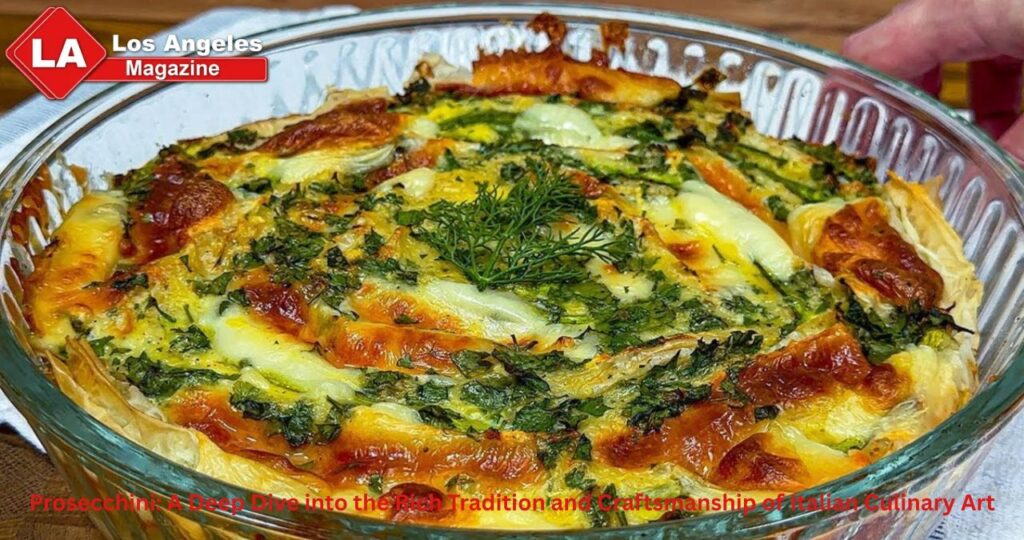Italian cuisine is renowned worldwide for its rich flavors, high-quality ingredients, and centuries-old traditions. One of the most beloved aspects of Italian cooking is its pasta, a staple found in virtually every Italian dish. Among the many varieties of pasta, one stands out for its unique shape, history, and the skill involved in its creation: prosecchini. Though less well-known than some other pasta types, prosecchini plays a significant role in Italy’s diverse culinary landscape. In this article, we will explore the origins, preparation methods, and the cultural importance of prosecchini, shedding light on why this particular type of pasta deserves more attention.
What Are Prosecchini?
Prosecchini are a traditional Italian pasta variety, hailing from the southern regions of Italy, particularly Calabria. They are small, elongated tubes of pasta, similar in shape to penne but much smaller and with a finer texture. Their delicate design makes them perfect for holding a variety of sauces, whether creamy, tomato-based, or rich in oils and herbs. Prosecchini are often considered to be an artisanal product, crafted by hand in many small, family-run pasta factories.
While prosecchini may not have the same level of international recognition as pasta varieties like spaghetti or fusilli, their unique shape and texture make them an ideal choice for pairing with a wide range of traditional Italian dishes. The pasta’s fine structure ensures that it absorbs sauces effectively, resulting in a satisfying and flavorful meal.
The Origin of Prosecchini
The origins of prosecchini can be traced back to the southern Italian regions, where pasta-making has been an integral part of local culinary traditions for centuries. Southern Italy, and particularly Calabria, has a long history of pasta production, with many recipes passed down through generations. Prosecchini, like many other regional pasta varieties, has roots in local agriculture and the need to create simple, hearty dishes using locally available ingredients.
Calabria’s geographic location, with its mountainous terrain and proximity to the Mediterranean Sea, has greatly influenced its culinary culture. The region is known for its use of fresh produce, rich olive oil, and local spices. Prosecchini, made from durum wheat semolina, are the perfect vehicle for showcasing these bold flavors. Traditionally, pasta was made by hand using a rolling pin and other simple tools, a method that continues to be used in many Calabrian households today. In these rural communities, prosecchini were often prepared for festive occasions, family gatherings, and large communal meals, cementing the pasta’s role in Italian culture.
How Are Prosecchini Made?
The process of making prosecchini is an art form that requires both skill and patience. Traditionally, the pasta dough is made from durum wheat semolina, which gives the pasta its firm texture and ability to hold its shape during cooking. The dough is kneaded by hand and then rolled out into thin sheets. The sheets are cut into small pieces, each of which is carefully rolled into the signature tube shape.
In traditional pasta-making, prosecchini are formed by pressing the dough around a small metal rod or using a wooden board with grooves to create the tube shape. This step requires a steady hand and a deep understanding of pasta craftsmanship. While modern machines have streamlined this process, many artisanal producers still follow this traditional method, ensuring that the texture and quality of the pasta remain true to its roots.
Once shaped, prosecchini are typically dried, either by air-drying or using low-temperature ovens, to preserve their flavor and texture. The drying process is essential for ensuring that the pasta can be stored for longer periods and shipped to markets around the world.
The Role of Prosecchini in Italian Cuisine
Although prosecchini are not as widely recognized internationally as pasta shapes like spaghetti or ravioli, they play a significant role in the rich tapestry of Italian cuisine. Their small size and ability to absorb sauces make them an excellent choice for a variety of dishes.
Prosecchini are commonly paired with a range of sauces, from simple olive oil and garlic to more complex tomato-based sauces and ragù. Their small size allows them to be easily incorporated into soups and stews, where they can absorb the rich flavors of the broth. Additionally, prosecchini can be baked in casseroles, often combined with cheese, vegetables, and meats for a comforting and hearty meal.
One classic Italian dish that often features prosecchini is “Pasta alla Calabrese,” a flavorful pasta dish from Calabria that incorporates spicy sausage, peppers, and tomatoes. The small pasta shape is perfectly suited for this dish, as it allows the sauce to cling to the pasta, delivering bursts of flavor with every bite. Prosecchini also pair beautifully with seafood, as their delicate texture complements the lightness of fish-based sauces.
Beyond savory dishes, prosecchini can also be used in sweeter pasta preparations. In some regions, they are boiled and then served with a dusting of sugar and cinnamon, creating a simple but delicious dessert.
The Artisanal Craft of Prosecchini
One of the standout features of prosecchini is their artisanal production. While mass-produced pasta is widely available in supermarkets, prosecchini are often made in small batches by local pasta makers who are dedicated to preserving traditional techniques. These artisanal producers take great pride in their craft, using high-quality semolina and traditional methods to create pasta that is not only delicious but also a reflection of their cultural heritage.
The craftsmanship involved in making prosecchini goes beyond the physical act of shaping the dough. It is also about maintaining the integrity of Italian culinary traditions and honoring the history of pasta-making in regions like Calabria. Each batch of prosecchini tells a story of family traditions, local agriculture, and regional pride.
Many small-scale producers of prosecchini emphasize the importance of using only the finest ingredients, such as locally sourced durum wheat semolina, and ensuring that every step of the process is done with care. The result is a pasta that stands out for its superior texture, flavor, and authenticity.
The Cultural Significance of Prosecchini
In many ways, prosecchini are more than just a type of pasta; they are a symbol of Italian culture and craftsmanship. The art of pasta-making is a deeply ingrained tradition in Italy, passed down through generations and celebrated as part of the country’s rich culinary heritage. By preserving and promoting traditional pasta varieties like prosecchini, Italian artisans are not only creating delicious food but also safeguarding a vital part of the country’s cultural identity.
The preparation of prosecchini is often a communal activity, with families coming together to make pasta for special occasions and festive gatherings. This practice fosters a sense of community and reinforces the importance of food as a means of bringing people together. In this way, prosecchini serve as a reminder of the value of tradition, family, and the joy of sharing a meal.
Prosecchini in the Modern World
As global interest in Italian cuisine continues to grow, the demand for traditional pasta varieties like prosecchini has also increased. Today, prosecchini are available in select gourmet shops and Italian markets worldwide, allowing people outside of Italy to experience the rich flavors of this artisanal pasta. Many food enthusiasts and chefs are rediscovering the beauty of regional pasta varieties, seeking out authentic products like prosecchini to elevate their dishes and bring a taste of Italy into their kitchens.
As the world becomes more interested in artisanal and locally sourced products, prosecchini are well-positioned to find a place on the global culinary stage. The pasta’s delicate texture, ability to hold sauces, and versatility make it a valuable addition to any kitchen.
Conclusion
Prosecchini may not be as well-known as some of Italy’s other pasta shapes, but they represent a vital part of the country’s rich culinary tradition. With their delicate texture, artisanal craftsmanship, and ability to complement a wide range of sauces, prosecchini are a true testament to the skill and passion of Italian pasta makers. As interest in traditional, handmade foods continues to grow, prosecchini offer a unique and delicious way to experience the heart and soul of Italian cuisine.
Whether you are an aspiring chef, a food lover, or someone looking to explore the diverse world of Italian pasta, prosecchini are a perfect choice for your next culinary adventure.



